Introduction
In general, Raphanus raphanistrum subsp. sativus (radish) recognized as the root vegetable was used for the human diet all over the world [1]. Many people would like to eat untreated raw radishes as a crunchy vegetable, and some people of the Middle East tried to drink the juice of Raphanus raphanistrum subsp. sativus (radish) so as to take various health benefits [1] (Fig. 1). The skin color of Raphanus raphanistrum subsp. sativus (radish) were known to vary widely such as red, purple, black, yellow, and white through pink, and so on, but the inside color of Raphanus raphanistrum subsp. sativus (radish) was generally white [1]. Furthermore, the flavor, length and size of Raphanus raphanistrum subsp. sativus (radish) that could be eaten in each country were reported to be very diverse [1,2]. As it had been know, Raphanus raphanistrum subsp. sativus (radish) was typically composed of carbohydrates, dietary fibers, fat, fluoride, minerals (calcium, iron, magnesium, manganese zinc, potassium, phosphorous, etc), protein, sugar, water-soluble vitamins (B1, B2, B3, B5, B6, B9, and C) [3].
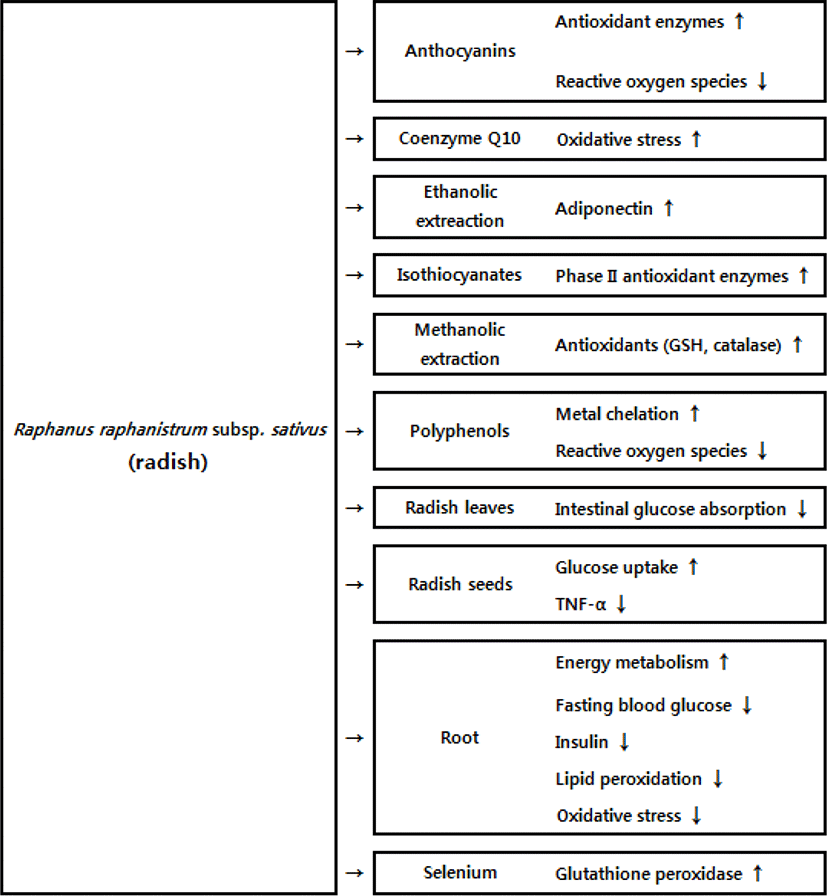
Recently, a variety of studies have revealed the efficacy of Raphanus raphanistrum subsp. sativus (radish) in improving human health. Until now, the major bioactive substances found in Raphanus raphanistrum subsp. sativus (radish) were (1) glucosinolates such as glucoerucin, glucoraphanin, glucoraphasatin, glucobrassicin, 4-hydroxyglucobrassicin, 4-methioxyglucobrassicin and neoglucobrassicin, and (2) isothiocyanates such as indole-3-carbinol, sulforaphane and sulforaphene [4–6]. Among the various bioactive substances, isothiocyanates was a particularly important bioactive substance of Raphanus raphanistrum subsp. sativus (radish) [6]. The isothiocyanates were breakdown products resulting from the enzymatic hydrolysis of glucosinolates by myrosinase. Since Raphanus raphanistrum subsp. sativus (radish) had myrosinase, and also the enzymatic activity of myrosinase was present in the intestinal microflora of the human colon [1,6,7].
Now, the number of diabetic people was dramatically uprising every year. Hence, the diabetes was recognized as a very difficult problem to solve medically, since it was a serious illness characterized by uncontrolled glucose hemostasis [8]. Furthermore, the diabetes was one of the top leading causes of death in humans [9]. Therefore, lots of researches were concentrated to find out the effective oral remedy and (or) home treatment to handle the diabetes were still direly needed [1]. The WHO-affiliated committee of diabetic experts strongly suggested the need to investigating the antidiabetic substance derived from the origin of plants, although there were unwanted side effects of it which were not fully known scientifically [1,10,11]. Until now, gastrointestinal irritation, nausea, and thyrotropin suppression were known as the adverse effect of synthetic hypoglycemic drugs [10,11].
Consequently, the final goal of this study was to produce market milk, yoghurt and Kefir added with Raphanus raphanistrum subsp. sativus‘s (radish) powder for helping the preventive diabetes and also improving organoleptic characteristics. In this experiment, among various physicochemical characteristics of dairy products, organoleptic characteristics of market milk, yoghurt and Kefir added with Raphanus raphanistrum subsp. sativus‘s (radish) powder were analyzed.
Materials and Methods
The power type of Raphanus raphanistrum subsp. sativus‘s (radish) was produced in Korean and bought form Heungyildang Food of Korea, and also was the food additive grade used in this study.
The powder of Raphanus raphanistrum subsp. sativus’s (radish) was added to market milk (Seoul Dairy Co-op, Korea) at concentrations of 0% (control), 1.0%, 2.0%, 3.0%, and 4.0%, respectively, and then mixed thoroughly). Then, the market milk with Raphanus raphanistrum subsp. sativus’s (radish) powder was kept at 4°C.
According to the instruction given by Kim et al. [12], Raphanus raphanistrum subsp. sativus‘s (radish) powder was added to yoghurt premix at concentrations of 0% (control), 0.5%, 2.0%, 3.0%, and 4.0%, and then mixed thoroughly. In this study, a ready-mixed starter culture (Lyofast YAB 450AB, Sacco srl., Codaragok, Italy) consisted of Streptococcus thermophiles, Lactobacillus delbrueckii ssp. bulgaricus, Lactobacillus acidophilus, and Bifidobacterium animalis ssp. lactis was artificially inoculated and then fermented at 42°C for at least 5 hours. The yoghurt was kept at around 4°C for one day (over 18 hours).
According to the instruction given by Kim et al. [13], Kefir was manufacture by Kefir grains obtained from KU Center for Food Safety, College of Veterinary Medicine, Konkuk University in Seoul, Korea. Then Kefir samples were added with different concentration of Raphanusraphanistrum subsp. sativus‘s (radish) powder (control as 0%, 1.0%, 2.0%, 3.0%, and 4.0%). The final Kefir products were cooled at 4°C and then stored in a refrigerator (Fig. 2).
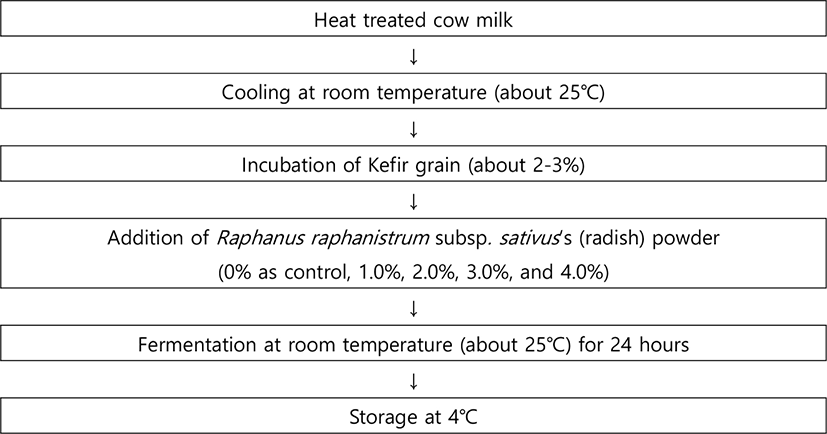
The organoleptic characteristics were analyzed by 12 trained panelists between 20 and 50 years of age who gave written informed consent after explanation of risk-benefits of participation prior to the study. The samples was randomly served in single-use plastic cups (10 mL) about 10°C, and all evaluators completed a test assessment form to compare five different organoleptic characteristics such as taste, flavor, color, texture and overall acceptability with the five-point hedonic scale (5 as excellent; 4 as good; 3 as fair; 2 as poor; and 1 as extremely poor).
Results and Discussion
The market milk was prepared with addition of Raphanus raphanistrum subsp. sativus’s (radish) powder at concentrations of 0% (as control), 1.0%, 2.0%, 3.0%, and 4.0%, respectively, and the results were summarized in Fig. 3.
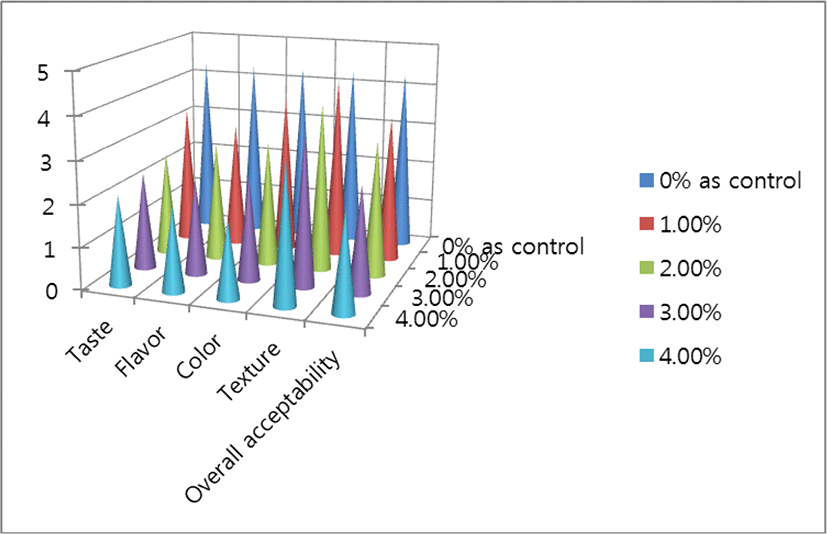
The scores of taste in market milk with Raphanus raphanistrum subsp. sativus’s (radish) powder (control as 0%, 1.0%, 2.0%, 3.0%, and 4.0%) showed 4.33, 3.33, 2.5, 2.33, and 2.16, respectively. The scores of color in market milk with Raphanus raphanistrum subsp. sativus’s (radish) powder (control as 0%, 1.0%, 2.0%, 3.0%, and 4.0%) showed 4.33, 3.0, 2.83, 2.33, and 2.0, respectively. The scores of flavor in market milk with Raphanus raphanistrum subsp. sativus’s (radish) powder (control as 0%, 1.0%, 2.0%, 3.0%, and 4.0%) showed 4.33, 3.83, 3.0, 2.5, and 1.83, respectively. The scores of texture in market milk with Raphanus raphanistrum subsp. sativus’s (radish) powder (control as 0%, 1.0%, 2.0%, 3.0%, and 4.0%) showed 4.33, 4.33, 4.0, 3.66, and 3.33, respectively. And the scores of overall acceptability in market milk with Raphanus raphanistrum subsp. sativus’s (radish) powder (control as 0%, 1.0%, 2.0%, 3.0%, and 4.0%) showed 4.33, 3.5, 3.25, 2.54, and 2.37, respectively.
According to statistical analysis of the organoleptic characteristics in market milk, there was statistical difference in taste, flavor, color, texture and overall acceptability between treated group and control group (p<0.05). Consequently, the scores of taste, flavor, texture and overall acceptability were lower in Raphanus raphanistrum subsp. sativus’s (radish) powder-containing market milk with 1.0%, 2.0%, 3.0%, and 4.0% than with the control group (0%).
The yoghurt was prepared with Raphanus raphanistrum subsp. sativus‘s (radish) powder at concentrations of 0% (as control), 1.0%, 2.0%, 3.0%, and 4.0%, respectively, and the results were summarized in Fig. 4.
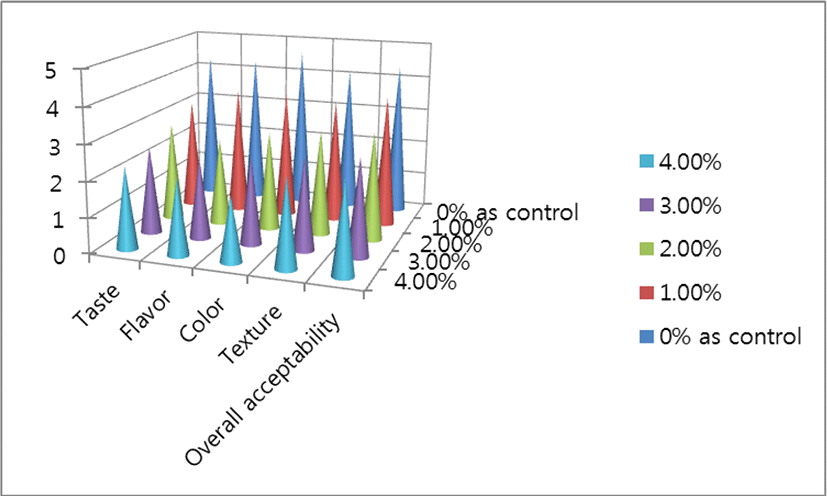
The scores of taste in yoghurt with Raphanus raphanistrum subsp. sativus’s (radish) powder (control as 0%, 1.0%, 2.0%, 3.0%, and 4.0%) showed 4.33, 3.16, 2.83, 2.5, and 2.33, respectively. The scores of color in yoghurt with Raphanus raphanistrum subsp. sativus’s (radish) powder (control as 0%, 1.0%, 2.0%, 3.0%, and 4.0%) showed 4.66, 3.66, 2.83, 2.5, and 1.83, respectively. The scores of flavor in yoghurt with Raphanus raphanistrum subsp. sativus’s (radish) powder (control as 0%, 1.0%, 2.0%, 3.0%, and 4.0%) showed 4.33, 3.66 2.5, 2.33, and 2.16, respectively. The scores of texture in yoghurt with Raphanus raphanistrum subsp. sativus’s (radish) powder (control as 0%, 1.0%, 2.0%, 3.0%, and 4.0%) showed 4.16, 3.5, 3.0, 2.66, and 2.5, respectively. And the scores of overall acceptability scores in yoghurt with Raphanus raphanistrum subsp. sativus’s (radish) powder (control as 0%, 1.0%, 2.0%, 3.0%, and 4.0%) showed 4.41, 3.75, 3.08, 2.75, and 2.62, respectively. Consequently, among the treated group compared with the control group (0%), the scores of taste, flavor, texture and overall acceptability were the same or lower in Raphanus raphanistrum subsp. sativus’s (radish) powdercontaining yoghurt with 1.0%, 2.0%, 3.0%, and 4.0%.
According to statistical analysis of the organoleptic characteristics in yoghurt, there was statistical difference in taste, flavor, color, texture and overall acceptability between treated group and control group (p<0.05). To summarize the results of this study, the scores of taste, flavor, color, texture and overall acceptability decreased in proportion to the added amount of Raphanus raphanistrum subsp. sativus’s (radish) powder.
Kefir was prepared with Raphanus raphanistrum subsp. sativus’s (radish) powder at concentrations of 0% (as control), 1.0%, 2.0%, 3.0%, and 4.0%, respectively, and the results were summarized in Fig. 5.
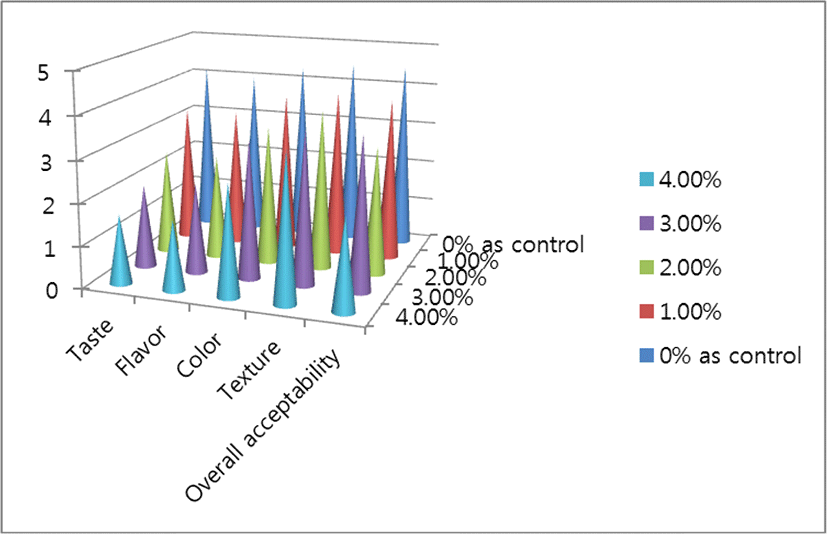
The scores of taste in Kefir with Raphanus raphanistrum subsp. sativus’s (radish) powder (control as 0%, 1.0%, 2.0%, 3.0%, and 4.0%) showed 4.16, 3.33, 2.5, 2.0, and 1.66, respectively. The scores of color in Kefir with Raphanus raphanistrum subsp. sativus’s (radish) powder (control as 0%, 1.0%, 2.0%, 3.0%, and 4.0%) showed 4.33, 3.83, 3.33, 3.33, and 2.66, respectively. The scores of flavor in Kefir with Raphanus raphanistrum subsp. sativus’s (radish) powder (control as 0%, 1.0%, 2.0%, 3.0%, and 4.0%) showed 4.0, 3.33 2.5, 2.16, and 1.66, respectively. The scores of texture in Kefir with Raphanus raphanistrum subsp. sativus’s (radish) powder (control as 0%, 1.0%, 2.0%, 3.0%, and 4.0%) showed 4.5, 4.0, 3.83, 3.66, and 3.5, respectively. And the scores of overall acceptability scores in Kefir with Raphanus raphanistrum subsp. sativus’s (radish) powder (control as 0%, 1.0%, 2.0%, 3.0%, and 4.0%) showed 4.5, 3.91, 3.66, 3.08, and 2.2, respectively.
According to statistical analysis of the organoleptic characteristics in Kefir, there was not any statistical difference in color and flavor, but in taste, texture and overall acceptability between control group and treated group (p<0.05). Subsequently, among the treated group compared with the control group (0%), the scores of taste, flavor, color texture and overall acceptability were lower in Raphanus raphanistrum subsp. sativus’s (radish) powder-containing Kefir with 1.0%, 2.0%, 3.0%, and 4.0%.
Furthermore, Fig. 6 showed the color changes of market milk-, yoghurt-, and Kefir- added with Raphanus raphanistrum subsp. sativus’s (radish) powder with 0% (control), 1.0%, 2.0%, 3.0%, and 4.0%. Although Raphanus raphanistrum subsp. sativus (radish) may be effective in diabetes from previous studies, many future studies will have to be conducted to improve human health and also visual improvements in dairy products when it becomes food additives.
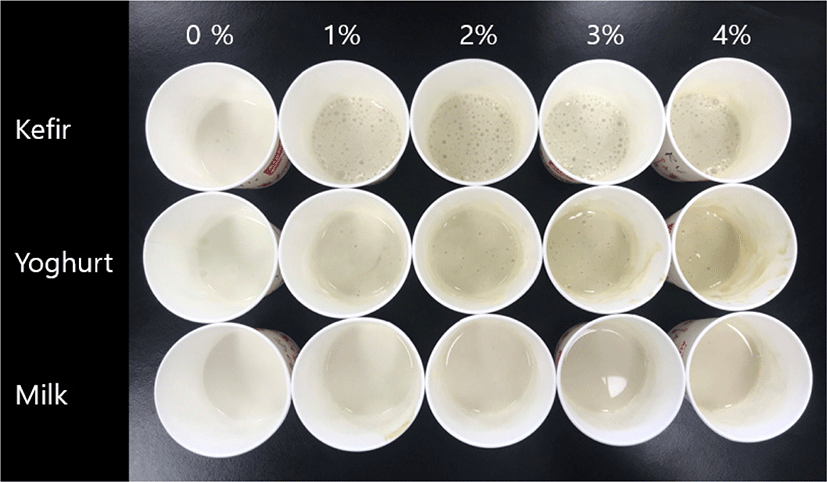
Up to now, almost all researches published with direct links between Raphanus raphanistrum subsp. sativus (radish) and diabetes have been conducted in a nonclinical state through in vivo and in vitro [1]. According to Banihani [1], the main studies were done on Raphanus raphanistrum subsp. sativus (radish) and its extracts to have the effect on various diabetic parameters. Also all the studies were able to confirm the presence of the hypoglycemic effect of Raphanus raphanistrum subsp. sativus (radish) [1]. The water-soluble Raphanus raphanistrum subsp. sativus (radish) extract showed an advantage in the hypoglycemic response over the fat-soluble extract, but the fat-soluble extract was found to play a role in lipid metabolism [14]. It was suggested that the water-soluble extract contains insulin-like components such as polyphenolic substances or glucosidase-inhibiting components [1,14,15]. Aly et al. reported that the histopathological examination of the pancreas had significant changes in the streptozotocininduced diabetic rats fed with Raphanus raphanistrum subsp. sativus (radish) of Egyptian at 10% for 6 weeks [16]. Tiwari et al. suggested that Raphanus raphanistrum subsp. sativus (radish) would have a potent antidiabetic activity, since Raphanus raphanistrum subsp. sativus (radish) could significantly reduce the starch inducedpostprandial glycemic load [17]. In other words, these proofs could prove that Raphanus raphanistrum subsp. sativus (radish) and its extracts were very effective for diabetes and diabetic conditions. Also according to Baenas et al. [6], the level of blood glucose could be lower by about 33.4% after the diabetic rats fed with lyophilized Raphanus raphanistrum subsp. sativus (radish) root-juice at 300 mg/kg of body weight and then fasted for 6 hours. Namely, the dose like this had therapeutic effect was equivalent to about 48.39 mg/kg of body weight in human [18]. Therefore, the effective therapeutic dosage was about 2903 mg of lyophilized Raphanus raphanistrum subsp. sativus (radish) root-juice in human (a man or woman) weighing 60 kg, and this amount was equal to about 0.726 kg extracted from Raphanus raphanistrum subsp. sativus (radish) [1,2].
In conclusion, Raphanus raphanistrum subsp. sativus (radish) could have the antidiabetic activity due to various factors such as (1) the enhancement of the antioxidant defense mechanism, (2) the decrease of oxidative stress and lipid peroxidation, (3) improvement of hormonal-induced glucose hemostasis, (4) the promotion of glucose uptake and energy metabolism, (5) the reduction of glucose absorption in the intestine, and so on [1,2,6,14–16].
Therefore, future studies will need to keep the high quality of organoleptic characteristics of food including dairy products added with Raphanus raphanistrum subsp. Sativus’s (radish) powder and its extracts and to prevent diabetes.
